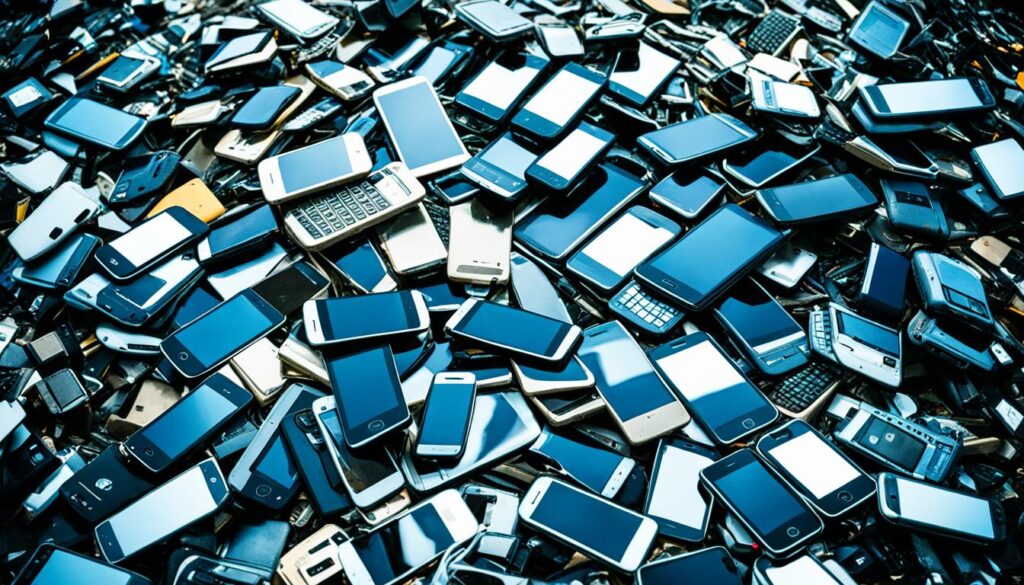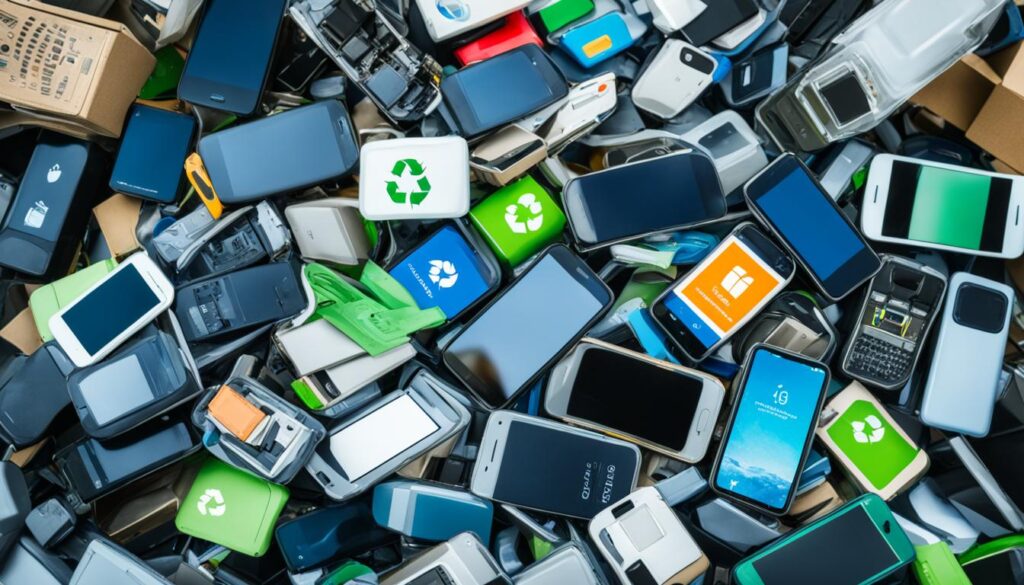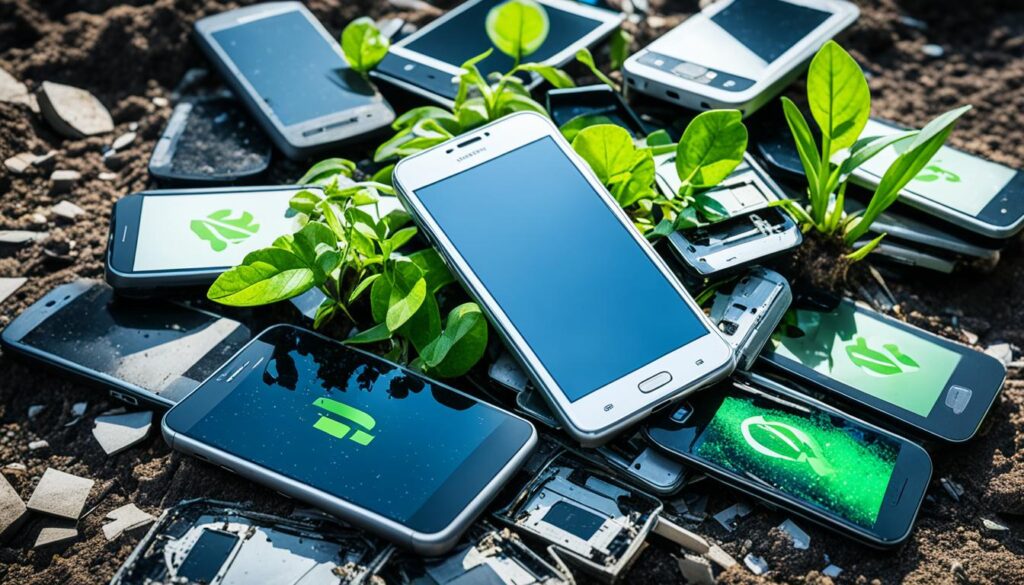Green Your Tech: Smartphone Recycling Guide
Did you know that over 152 million smartphones are discarded every year in the United States alone? That’s enough electronic waste to fill 55 Olympic-sized swimming pools! The rapid pace of technological advancements has led to a staggering amount of smartphone waste, posing significant environmental challenges.
In this comprehensive guide, we will explore the importance of smartphone recycling and provide you with essential information on how to properly dispose of your old devices. By adopting eco-friendly practices, you can reduce e-waste, minimize the carbon footprint of smartphone manufacturing and disposal, and contribute to resource conservation.
Key Takeaways:
- Smartphone recycling plays a crucial role in reducing electronic waste.
- Proper smartphone disposal helps minimize the carbon footprint of manufacturing and disposal.
- Recycling provides an opportunity to conserve valuable resources.
- By choosing responsible recyclers, you can ensure your data security.
- Implementing best practices for smartphone recycling contributes to a more sustainable tech ecosystem.
The Environmental Impact of Smartphones
In this section, we will delve into the environmental impact of smartphones. We will discuss the effects of e-waste on the environment and the need for proper smartphone recycling. Additionally, we will explore the carbon footprint associated with the manufacturing and disposal of smartphones, as well as the depletion of valuable resources. Understanding these factors is crucial for making informed decisions about smartphone disposal.
Understanding E-Waste and Smartphones
E-waste refers to electronic waste, which includes discarded electronic devices such as smartphones. The rapid advancement of technology and the high turnover rate of smartphones contribute to the growing e-waste problem worldwide. When smartphones are improperly disposed of, they contribute to landfills, releasing hazardous substances into the environment. These substances can pollute soil and water, harming both human health and ecosystems.
The Carbon Footprint of Manufacturing and Disposal
The manufacturing and disposal of smartphones generate a significant carbon footprint. The production process involves extracting raw materials, manufacturing components, assembling devices, and transporting them to market. Each step contributes to greenhouse gas emissions, particularly carbon dioxide, which contributes to climate change. Additionally, the improper disposal of smartphones leads to the release of harmful emissions during incineration or decomposition in landfills.
Resource Depletion: Why Recycling Matters
The manufacturing of smartphones requires the extraction of finite resources like rare earth metals, minerals, and energy-intensive materials. These resources are not only limited in supply but also contribute to environmental degradation and ecosystem disruption during extraction. By recycling smartphones, we can recover valuable materials and reduce the need for further resource extraction, promoting sustainability and conservation.
Smartphone Lifecycle: From Creation to Waste

In this section, we will explore the entire lifecycle of a smartphone, from its creation to its eventual disposal. Understanding the various stages of the smartphone lifecycle is crucial for comprehending the environmental impact of these devices and identifying opportunities for sustainable practices.
The lifecycle of a smartphone can be divided into four main stages:
- Manufacturing: This stage involves sourcing raw materials, assembling components, and manufacturing the smartphone. It requires significant energy consumption, water usage, and the extraction of precious metals and minerals.
- Distribution: After production, smartphones are distributed to retailers and consumers worldwide. This stage involves packaging, transportation, and logistics, contributing to carbon emissions and waste generation.
- Use: During this stage, consumers utilize their smartphones for communication, entertainment, and various other purposes. Although the use phase does not directly contribute to electronic waste (e-waste), it impacts energy consumption and carbon emissions through charging, data usage, and device maintenance.
- End-of-life: Once a smartphone reaches the end of its usable life, it becomes electronic waste. Improper disposal of e-waste can have detrimental effects on the environment and human health. It is essential to recycle smartphones to recover valuable resources and minimize the negative impact on our planet.
By understanding the complete product lifecycle, we gain insight into the challenges and opportunities for sustainable practices in each stage. From implementing eco-friendly manufacturing processes to encouraging responsible consumer behavior, every step counts in mitigating the environmental impact of smartphones.
Preparing Your Smartphone for Recycling
This section will guide you through the necessary steps to prepare your smartphone for recycling. It is essential to take these precautions to ensure the proper handling of your device and protect your personal information.
Data Backup and Factory Reset
Before recycling your smartphone, it is crucial to back up your data to prevent any loss of valuable information. You can back up your photos, videos, contacts, and other important files by connecting your device to a computer or using cloud storage services. Once you have completed the backup, perform a factory reset to erase all the data and settings on your smartphone. This step will help protect your privacy and ensure that no personal information remains on the device.
Removing SIM and SD Cards
Prior to recycling your smartphone, remove the SIM card and SD card from the device. The SIM card contains personal information, such as contacts and text messages, while the SD card stores files and media. Safely eject these cards and keep them for potential use in your new device or secure disposal.
Assessing Your Smartphone’s Condition
Before recycling, it is essential to assess the condition of your smartphone. Check for any physical damage, such as cracks, dents, or water damage. Determine if the device is still functional or if it has any performance issues. This assessment will help determine the appropriate recycling options for your smartphone, whether it can be refurbished or if it needs to be recycled for its components.
Smartphone Recycling Options and How They Work

When it comes to smartphone recycling, there are several options available to consumers. By choosing the right recycling method, you can ensure that your old devices are disposed of responsibly, minimizing their impact on the environment. In this section, we will explore the different smartphone recycling options and how they work.
Local Collection Points and E-Waste Centers
One option for recycling your smartphone is to take it to a local collection point or e-waste center. These facilities are specifically designed to handle electronic waste, including smartphones. They have the infrastructure and expertise to properly recycle and dispose of your device in an environmentally friendly manner. By using local collection points and e-waste centers, you can conveniently drop off your old smartphone and ensure that it is recycled responsibly.
Mail-in Recycling Programs
If you are unable to access a local collection point or e-waste center, another option is to participate in mail-in recycling programs. Many organizations and companies offer mail-in recycling services, allowing you to ship your old smartphone to a designated recycling facility. These programs often provide pre-paid shipping labels, making the process easy and accessible. By choosing a reputable mail-in recycling program, you can contribute to the recycling efforts and reduce e-waste, even if you don’t have a local collection point nearby.
Retailer Take-Back Initiatives
Several retailers have implemented take-back initiatives to encourage smartphone recycling. These initiatives allow customers to return their old devices to the retailer for proper disposal. Retailers often partner with certified e-waste recyclers to ensure that the smartphones are recycled in an environmentally responsible manner. By participating in retailer take-back initiatives, you can conveniently recycle your smartphone while taking advantage of the infrastructure already in place at the retailer.
To summarize, consumers have multiple options for recycling their smartphones. Whether utilizing local collection points, participating in mail-in recycling programs, or taking advantage of retailer take-back initiatives, the aim is to ensure proper disposal and reduce e-waste. Choosing a recycling option that aligns with your needs and location will enable you to contribute to a more sustainable tech ecosystem, minimizing the impact on the environment.
Understanding the Smartphone Recycling Process
In this section, we will provide an in-depth understanding of the smartphone recycling process. It is essential to comprehend how smartphones are recycled to evaluate the effectiveness of recycling efforts and the environmental benefits they bring.
Smartphone recycling begins with collection. Various methods, such as drop-off points, e-waste centers, and mail-in programs, facilitate the collection of old smartphones. These collection points play a vital role in ensuring proper disposal and preventing these devices from ending up in landfills or being improperly recycled.
Once collected, the smartphones undergo a meticulous recycling process. They are first sorted to identify the different materials present, such as metals, plastics, and glass. The separation of these components allows for efficient recycling and recovery of valuable resources.
Next, the smartphones are disassembled, and the various parts and components are further separated and processed. This step helps to extract valuable metals like gold, silver, and copper, which can be reused in the manufacturing of new devices.
After the valuable materials have been recovered, the remaining components are further treated for safe disposal or recycling. This includes properly handling hazardous substances and ensuring compliance with environmental regulations.
Finally, the recycled materials are sent to specialized recycling facilities. These facilities use advanced technologies to process the recovered materials and transform them into reusable raw materials. The recycled materials can then be used in the manufacturing of new products, reducing the need for extracting new resources.
The smartphone recycling process provides numerous environmental benefits. It reduces the demand for raw materials, conserves energy, minimizes greenhouse gas emissions, and prevents the accumulation of electronic waste. By participating in smartphone recycling, individuals can contribute to a more sustainable and circular economy.
How to Choose a Responsible Smartphone Recycler

When it comes to smartphone recycling, it’s important to choose a responsible recycler that prioritizes proper handling and disposal of electronic waste. By selecting certified e-waste recyclers, you can ensure that your old devices are recycled in an environmentally-friendly manner. In this section, we will guide you through the process of choosing a responsible smartphone recycler. We will also highlight the significance of data security in the recycling process.
Identifying Certified E-Waste Recyclers
One of the key factors to consider when selecting a smartphone recycler is their certification as an e-waste recycling facility. Look for recyclers that have obtained certifications from recognized organizations, such as the e-Stewards and R2 Responsible Recycling standards. These certifications require recyclers to adhere to strict environmental and ethical standards in the handling and disposal of electronic waste.
Key Questions to Ask Before Recycling
Before handing over your smartphone to a recycler, it’s important to ask a few key questions to ensure that they are committed to responsible recycling practices. Some questions to consider asking include:
- Do you have any certifications from recognized e-waste recycling standards?
- What measures do you take to protect the environment during the recycling process?
- How do you ensure data security during the recycling process?
- What types of materials do you recycle from smartphones?
- Do you have a transparent tracking system to trace the disposal of recycled devices?
Asking these questions will help you assess the commitment of a recycler to responsible and sustainable smartphone recycling.
The Importance of Data Security in Recycling
Data security is a crucial consideration when recycling smartphones. Before handing over your device, ensure that the recycler has robust data security protocols in place. They should provide clear guidelines on wiping and disposing of personal data from smartphones to protect your privacy. A responsible recycler will have procedures in place to ensure that no personal information remains on the device after recycling.
| Benefits of Choosing a Responsible Smartphone Recycler | Risks of Choosing an Unqualified Recycler |
|---|---|
|
|
Smartphone Recycling: Best Practices for Consumers

In order to contribute to a more sustainable tech ecosystem, it is essential for consumers to adopt best practices for smartphone recycling. By following eco-friendly disposal methods and implementing consumer tips, individuals can significantly reduce e-waste and maximize the environmental benefits of recycling.
One of the first steps in smartphone recycling is to properly dispose of your device. Instead of throwing it in the trash, explore the various options available for recycling. Local collection points and e-waste centers are convenient drop-off locations where you can deposit your old smartphones for recycling. Mail-in recycling programs and retailer take-back initiatives also provide easy and accessible avenues for recycling.
Before recycling your smartphone, it is important to ensure that your personal data is secure. Perform a data backup and factory reset to protect your information from falling into the wrong hands. Remove SIM and SD cards from your device to prevent any potential data breaches.
Assessing the condition of your smartphone is another crucial step in the recycling process. If the device is still in working condition, consider donating it to charities or non-profit organizations that accept used smartphones. This gives your device a second life and allows someone else to benefit from it.
To further reduce e-waste, consumers can also practice sustainable habits when it comes to upgrading their smartphones. Instead of automatically replacing your device with the latest model every time it is available, consider extending the lifespan of your current smartphone. Regular maintenance, such as replacing batteries or repairing broken screens, can help prolong the life of your device and reduce electronic waste.
By implementing these best practices, consumers can play a significant role in smartphone recycling and contribute to a more eco-friendly disposal process. Together, we can make a positive impact on the environment and create a sustainable future for our tech devices.
Conclusion
In conclusion, eco-friendly smartphone disposal is crucial for minimizing the environmental impact of our tech devices and promoting sustainability. Throughout this guide, we have explored the importance of smartphone recycling and provided essential information on how to properly dispose of our old devices.
Key takeaways for eco-friendly smartphone disposal include responsibly preparing your device for recycling by backing up data, factory resetting, and removing SIM and SD cards. It is equally important to choose a responsible smartphone recycler who follows certified e-waste recycling standards and prioritizes data security.
However, our green tech journey should not end with recycling. By continuing to make sustainable choices in our tech consumption and disposal practices, we can contribute to a greener future. This journey involves reducing e-waste, maximizing the lifespan of our devices, and exploring options for repair and refurbishment.
To encourage wider adoption of smartphone recycling practices, it is important to educate others about the environmental impact of electronic waste and the benefits of recycling. By sharing our knowledge and experiences, we can inspire individuals, communities, and businesses to prioritize eco-friendly tech practices and contribute to a more sustainable world.
